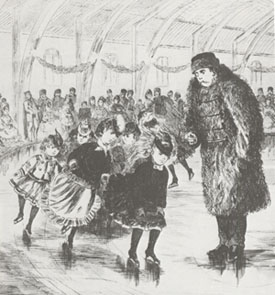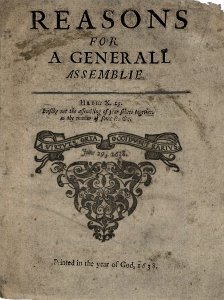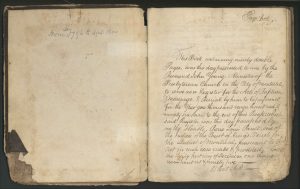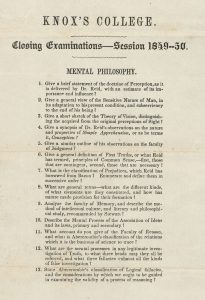The oldest document in our archives is a 10 page leaflet entitled “Reasons for a Generall Assemblie”. The leaflet was printed in Edinburgh on June 29, 1638. The same year that the National Covenant was signed at Greyfriars Kirk. [Reference #1973-1046-1-1]
Interesting Facts/Items
Interesting Facts/Items
The oldest Canadian church record in the Archives
The oldest Canadian Presbyterian church record in the Archives is a baptism, marriage and death register for St. Gabriel Street Presbyterian Church, Montreal, which begins in 1796. St. Gabriel Street Church. was founded in 1786 by the Rev. John Bethune. The first building (constructed in 1792) was located on the south-west corner of Champ de Mars. In 1909 this historic congregation amalgamated with Chalmer’s Presbyterian Church and took the name First Presbyterian Church, which through further amalgamations is now part of Knox, Cerscent, Kensington and First Presbyterian Church. [Reference #1976-4002-1-1]
How many records are there in the Archives?
The Archives holds approximately 3,500 square feet of textual records (roughly 7,500 boxes of documents). In addition, we also hold more than 1.5 million pages on microfilm.
How far would they extend if placed end to end?
If you placed each document from those 7,500 boxes end to end they would extend all the way from Toronto to Quebec City and back to Ottawa. Or, if you started in Calgary you would make it to Vancouver before running out!
[This is based on an average of 10 files per box with an average of 50 pages per file. This gives a total of 3.75 million pages. If each page is on average 21.5 x 28cm (ie. 8.5 x 11 inches) this equals 105 million centimetres or 1,050 kilometres!].
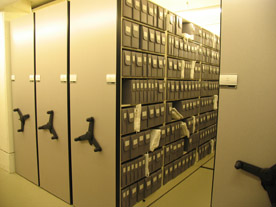
How many photographs are in the Archives?
We have approximately 15,000 photographs catalogued, scanned and entered into a searchable database within our office (sorry, it is not available via the Internet!). We also estimate another 5,000-10,000 exist in our backlog waiting to be catalogued and scanned.
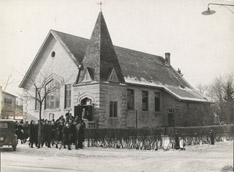
What is the oldest Presbyterian Church building in Canada?
The Kirk in St. George, New Brunswick, which was built in 1790.
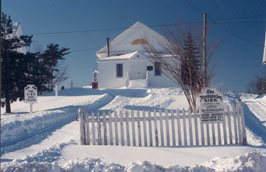
Early examination from Knox College
The First Women Commissioners to a General Assembly
Mrs. Forrester of Cardinal, Ontario and Miss Whale, Director of Overseas Missions for the WMS, were the first women commissioners to attend a General Assembly. This was at the 93rd General Assembly, held at Knox Presbyterian Church, Ottawa in 1967. Mrs. Forrester was a commissioner from the Presbytery of Brockville, and Miss Whale from the Presbytery of Brampton.
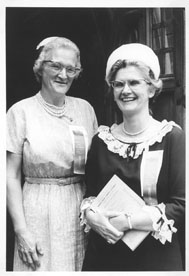
Moderator of the 1st General Assembly of The Presbyterian Church in Canada
The Rev. Dr. John Cook was elected Moderator of the First General Assembly of The Presbyterian Church in Canada when it was formed in 1875. The following is from his Memorial Record, printed in the 1892 Acts and Proceedings, “This well-known and distinguished divine, who for more than half a century occupied a prominent place in the Presbyterian Church, died at Quebec on the 31st March, 1892. In the brief space afforded here a very imperfect record can be given of the life, labours and character of Dr. Cook. He came from Scotland in 1836 and became pastor of St. Andrew’s Church, Quebec. His powerful intellect, his varied qualifications and the active interest which he took in everything connected with education and religion soon gave him a place of great influence in the Church and community. As a preacher he manifested remarkable power, his discussions were distinguished alike for clearness of thought, beauty of language and true eloquence. He rendered important services in various ways, and at different times to Queen’s University, and he was principal of Morrin College from its establishment to his death. He was twice Moderator of the Synod of the Presbyterian Church in connection with the Church of Scotland, and in 1875, when the great union was effected, he was regarded as the one best entitled to fill the position of Moderator. In the history of the Presbyterian Church in Canada the name of Dr. Cook will always shine forth as one of the most distinguished of her ministers and leaders.”
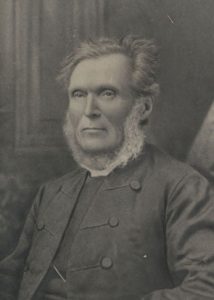
What does The Presbyterian Church in Canada and organized hockey have in common?
They both have their origins at the Victoria Skating Rink in Montreal in 1875! On March 3, 1875 the first recorded organized indoor hockey game was played at the Victoria Skating Rink. The modern game of hockey is often dated to this day. Just over 3 months later, on June 15, 1875 members from the four separate Presbyterian churches in Canada met within the Victoria Skating Rink to consummate the union of their churches and celebrate the formation of “The Presbyterian Church in Canada”. The first sederunt of that first General Assembly was held at the Rink, while the remaining sederunts were held within Erskine Church, Montreal.
